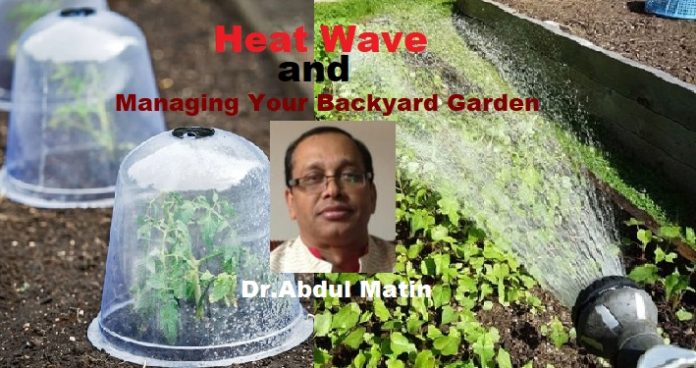In BC Canada, last couple of days had and more days in coming week will experience very high temp heat wave (more than 36 degrees C). You also may aware that some southern states of USA and Canada are seriously impacted by heat waves. During this time we must be careful about our own health including family members who enjoy working in backyard garden. Please do not go in your garden in high heat wave time specially when the temp is too high and in full sun to protect yourselves from heat strokes.
Drink plenty of water and keep yourself hydrated during this high temp and heat wave period. Try to go to garden either very early in morning or in evening when temp drops or in reduced heat.
Impact of heat wave on crops:
Extreme heat is not only stressful for many plants, but it can actually make many of them go dormant and stop growing – even if they are kept well watered. High heat can also keep plants from setting any fruit because extremely hot temperatures can kill the pollen. Other crops will bolt and go to seed extremely quickly. Plants in trellis are usually more affected by high temp or heat wave.
To keep your garden safe and growing please follow the following tips and enjoy gardening during heat wave:
a. apply mulch, preferably a reflective mulch such as dry grass clippings. Also 2-4 inches organic mulches are helpful to conserve soil moisture.
b. water your garden early in the morning and economic use of water as water scarcity may happen during heat wave.
c. use shade cloth or protective row covers.
d. locate new transplants within the cover of taller neighbors.
e. select locally grown heat or drought tolerance crop verities.
f. follow local cropping pattern and crop rotation to minimize crop failure and conserve soil moisture.
g. manage sun light. You can also create your own shade in your garden with sheets, tarps, or patio umbrellas.
h. make sure your soil has higher level of organic matter and benefial microorganisms which helps retain more water and drought tolerance.
i. Keep you plants well spaced and weed free.
j. Avoid raised beds gardening in high heat wave prone areas. Raised beds warm up more, and dry out more quickly – a disadvantage in hot climates. The soil is cooler and moister deeper down in the ground. So, in extremely hot dry climates, it is suggested focusing on improving the soil deeper down instead of creating raised beds.
k. Keep your lawns at least three inches tall.
Conclusions:
Heat waves usually are of short enough duration that gardeners can manage to produce successful crops. Prolonged heat waves, of course, are more challenging and crops may be stunted or crop yields reduced.
Look for those vegetables that were bred for the desert, the southern states, or the tropics. These include: tomatoes, eggplant, melons, peppers, malabar spinach, cowpeas, and lima beans. Sweet potatoes, okra, and southern peas can handle the most heat.
Due to global warming and climate change gardeners will experience more critical challenges due to heat wave and or very cold weather. Therefore, gardeners need to improve their gardening knowledge and skills for managing gardens and protect lovely vegetables from harsh weather condition.
By taking advantage of many of the tips listed above, you can continue to garden successfully during hot summer weather!
Enjoy happy gardening.







